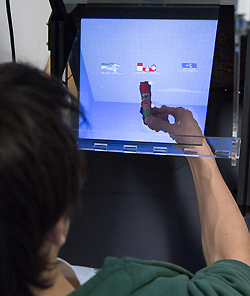Recent Stories
- Businesses urged to tap into science and technology young talent
- Digital relay baton enables remote crowd cheering of athletes
- Health Innovation Campus moves a step closer
- £7.1 million R&D boost for North West businesses
- Centre of excellence created for the next industrial revolution
- Artificial intelligence toolkit spots new child sexual abuse media online
- Strategic partnership set to help plug cyber security skills gap
- What your choice of smartphone says about you
- InfoLabTree: Discover the Story
- novi.digital Launch Event - 'An Event to Help Businesses Grow Online'
RSS Feeds
RSS feeds can deliver the latest InfoLab21 news and events direct to your browser without you having to visit the website.
In most browsers you can click on an RSS link and choose to subscribe to the feed to add it to your favourites or bookmarks.
Global award for research on human-computer interaction
Story supplied by LU Press Office
 An augmented reality interface allows for an easier design process
An augmented reality interface allows for an easier design process
Research by Lancaster University and Microsoft has won an award for Best Paper after being judged in the top one per cent of entries worldwide.
"MixFab:A mixed-reality environment for personal fabrication? creates a way for non-specialists to make their own 3D models and print them out.
The research is to be given the Best Paper award at the world-leading ACM SIGCHI Conference on Human Factors in Computing Systems, which takes place in Toronto in April 2014.
The authors are Christian Weichel, Dr Manfred Lau, and Professor Hans Gellersen from the School of Computing and Communications at Lancaster University and Microsoft's David Kim and Nicolas Villar (who completed a PhD at Lancaster before joining Microsoft in Cambridge).
Professor Gellersen said: "This marks the research as one of the most significant contributions to the field made over the last year."
Personal fabrication machines, such as 3D printers and laser cutters, are becoming increasingly ubiquitous. But designing objects for fabrication still requires 3D modelling skills, making them inaccessible without specialist training.
MixFab enables users to design objects in an immersive augmented reality environment, interact with virtual objects in a direct gestural manner and can introduce existing physical objects effortlessly into their designs.
Christian Weichel said: "MixFab is designed to lower the barrier for users to create content for 3D printing. By using augmented reality, users can create virtual 3D models of objects and see them projected into their working environment. They can shape the 3D models with intuitive hand gestures, and even use physical objects, for example to make the model fit to the shape of an existing object. Once they are done, the 3D model is printed out and immediately usable as a new physical object."
He said a problem which novices have is 3D manipulation and navigation in "flat" 3D design environments.
"However, we all know how to interact with 3D objects in the real world. MixFab transfers this knowledge into the design world by situating the design environment in the physical space and making the virtual objects handleable as if they were physical entities."
Fri 28 March 2014



